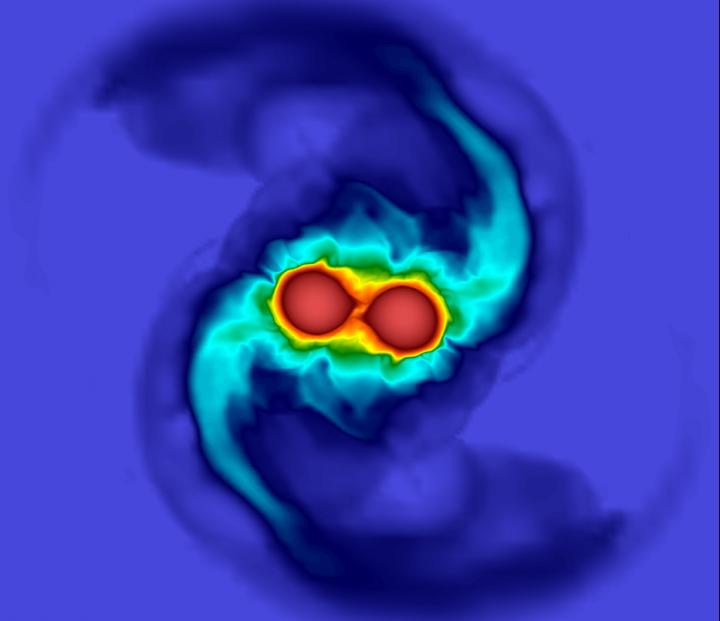New gravitational-wave model can bring neutron stars into even sharper focus

The results from a numerical relativity simulation of two merging neutron stars similar to GW170817. Credit: University of Birmingham
The model shows that vibrations, or oscillations, inside the stars can be directly measured from the gravitational-wave signal alone. This is because neutron stars will become deformed under the influence of tidal forces, causing them to oscillate at characteristic frequencies, and these encode unique information about the star in the gravitational-wave signal.
This makes asteroseismology — the study of stellar oscillations — with gravitational waves from colliding neutron stars a promising new tool to probe the elusive nature of extremely dense nuclear matter.
Neutron stars are the ultradense remnants of collapsed massive stars. They have been observed in the thousands in the electromagnetic spectrum and yet little is known about their nature. Unique information can be gleaned through measuring the gravitational waves emitted when two neutron stars meet and form a binary system.
First predicted by Albert Einstein, these ripples in spacetime were first detected by the Advanced Laser Interferometer Gravitational Wave Observatory (LIGO) in 2015.
By utilising the gravitational wave signal to measure the oscillations of the neutron stars, researchers will be able to discover new insights into the interior of these stars. The study is published in Nature Communications.
Dr Geraint Pratten, of the University of Birmingham's Gravitational Wave Institute, is lead author of the study. He explained: “As the two stars spiral around each other, their shapes become distorted by the gravitational force exerted by their companion. This becomes more and more pronounced and leaves a unique imprint in the gravitational wave signal.
“The tidal forces acting on the neutron stars excite oscillations inside the star giving us insight into their internal structure. By measuring these oscillations from the gravitational-wave signal, we can extract information about the fundamental nature and composition of these mysterious objects that would otherwise be inaccessible.”
The model developed by the team enables the frequency of these oscillations to be determined directly from gravitational-wave measurements for the first time. The researchers used their model on the first observed gravitational-wave signal from a binary neutron star merger – GW170817.
Co-lead author, Dr Patricia Schmidt, added: “Almost three years after the first gravitational-waves from a binary neutron star were observed, we are still finding new ways to extract more information about them from the signals. The more information we can gather by developing ever more sophisticated theoretical models, the closer we will get to revealing the true nature of neutron stars.”
Next generation gravitational wave observatories planned for the 2030s, will be capable of detecting far more binary neutron stars and observing them in much greater detail than is currently possible. The model produced by the Birmingham team will make a significant contribution to this science.
“The information from this initial event was limited as there was quite a lot of background noise that made the signal difficult to isolate,” says Dr Pratten. “With more sophisticated instruments we can measure the frequencies of these oscillations much more precisely and this should start to yield some really interesting insights.”
###
Notes to editor:
The University of Birmingham is ranked amongst the world's top 100 institutions. Its work brings people from across the world to Birmingham, including researchers, teachers and more than 6,500 international students from over 150 countries.
Pratten et al (2020). 'Gravitational-Wave Asteroseismology with Fundamental Modes from Compact Binary Inspirals'. Nature Communications.
Media Contact
All latest news from the category: Physics and Astronomy
This area deals with the fundamental laws and building blocks of nature and how they interact, the properties and the behavior of matter, and research into space and time and their structures.
innovations-report provides in-depth reports and articles on subjects such as astrophysics, laser technologies, nuclear, quantum, particle and solid-state physics, nanotechnologies, planetary research and findings (Mars, Venus) and developments related to the Hubble Telescope.
Newest articles

A ‘language’ for ML models to predict nanopore properties
A large number of 2D materials like graphene can have nanopores – small holes formed by missing atoms through which foreign substances can pass. The properties of these nanopores dictate many…

Clinically validated, wearable ultrasound patch
… for continuous blood pressure monitoring. A team of researchers at the University of California San Diego has developed a new and improved wearable ultrasound patch for continuous and noninvasive…

A new puzzle piece for string theory research
Dr. Ksenia Fedosova from the Cluster of Excellence Mathematics Münster, along with an international research team, has proven a conjecture in string theory that physicists had proposed regarding certain equations….



